By Alan Goldstein
When Ben E. Clement passed away in 1980, he left over 50,000 minerals to his family, encouraging them to create a mineral museum.
An avid field collector had a stroke in 2016. His collection, which included an estimated million specimens, filled a two-and-a-half-car garage and a pole barn. The spouse had to care for him. Dealing with the collection was a non-starter.
The daughter of two parents who collected minerals and fossils had a house full of specimens. Years after the mother passed, the elderly father had a stroke, requiring him to go into a nursing home. She needed to clean out the house to take care of her father.
A younger brother passes away unexpectedly, leaving a small collection of high-quality self-collected trilobites and prehistoric tools to his sister. She has no idea what to do with it.
These are four cases where families were left to deal with legacy collections resulting from lifelong interests in collecting by family members.
Do you have a plan for your collection?
What is a “legacy” collection?
I define it as a collection assembled throughout a collector’s life. Neither size nor quality is important. It can be field collected or purchased. It reflects the “soul” of the person or people who acquired the collection. While the collector lives, it is integrated into their life.
There are three parts in the life of a legacy collection. The first is why you collect. Second, what you do with your collection. Third, and this is the crux of this article, what can you do? What happens if you can’t disperse it?
Building your collection – Why do you collect?
Earth provides memorabilia that has a physical connection with something greater than oneself. It might be the beauty of a crystal or evidence of a curious animal or plant that lived millions of years ago. Looking for something new and interesting is one of the reasons many go collecting. Like the fishing mantra, a bad day collecting is still better than a good day at work (assuming the “bad” doesn’t refer to injury).
Rock, mineral, and fossil collecting is a fun and relaxing hobby. People with similar interests often come together through rockhound clubs. Yet, it can also be isolating: collecting may be a competition to find the best or rarest specimen. Creating lapidary art or faceting gemstones is usually done alone.
Personal collections share a trait with museums, the lack of space and the cost of having display cases, only a small fraction is often displayed. The bigger the collection, the smaller the percentage that can be displayed. The rest is stored in boxes on shelves or in drawers. Sometimes displays are rotated, bringing out specimens from time to time as others are put away. Many collectors “decorate” their yards with specimens.
Many specimens are not labeled, making their collection less valuable from both monetary and scientific perspectives. This diminishes the collector’s legacy. The more information saved, the better. For example, keeping labels with specimens! There are many itinerate localities that produce specimens over a short timeframe and then disappear forever.
Can you collect too much?
If you ask a family member, don’t be surprised if the answer is, “Yes!”
Why do we collect so much? A simple reason, “because it’s fun.” Collecting is part of human nature. Can there be a healthy balance between collecting and doing something constructive with what you collect? I’d like to think so.
Motivating factors to collect Earth’s treasures can be classified into several categories, and it’s not unusual for someone to have more than one reason. There is a difference between occupational collecting and collecting as a hobby. My focus is the latter. Reasons may include any or all of the following:
1) Lapidary activities like cutting and polishing to create something beautiful.
2) Prioritizing the displaying or competitive showing of specimens.
3) Selling fossils/minerals as an income supplement.
4) Learning/investigating things collected, such as fossils, microminerals, and fluorescents.
5) Sharing interests. Satisfaction is gained from giving away specimens to family, friends, or students.
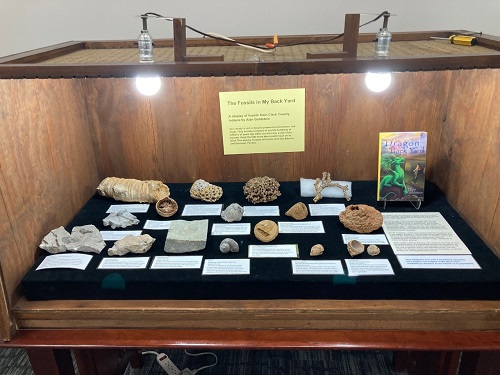
The Fossils in My Back Yard exhibit was in the Jeffersonville Library in 2021. This is one of an ongoing series of fossil and mineral displays at two libraries.
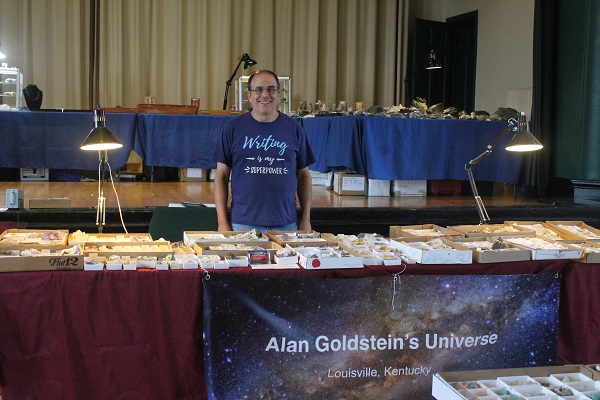
Alan Goldstein at the Clement Museum show in Marion, Kentucky.
Are There “Good” and “Bad” Collecting Practices?
Yes, and this affects the rockhound community. ‘Bad’ collecting may cause a site to be closed or left unusable for future rockhounds. Have you heard of South Dakota’s Cycad National Monument? No? That’s because it was created and later removed from the National Park Service land inventory because all the fossil cycads had been collected, leaving nothing for visitors to see or scientists to study.
When a collector ‘vacuums’ up everything at a collecting site or a group visits a site so often that nothing interesting can be found, that’s called ‘over-collecting.’ It removes the thrill of discovery. And that nurtures children’s interest in geology. Sometimes, a collecting site is permanently ruined. Sometimes, it takes months or years of ‘rest’ for weathering and erosion to make the land worth visiting again.
Some may include packing everything away rather than showing or sharing with others as ‘bad’ collecting. A ‘geological hoarder’ is a collector who collects and then doesn’t do anything with their specimens. It’s not my place to pass judgment, but acknowledge that it is one of the personalities of avid collectors. Hidden specimens might as well still be buried in bedrock. A hoarder’s collection disappears into a personal ‘black hole.’ The collector’s death may or may not bring the trove of specimens back to be enjoyed by others. Overwhelmed family members may be unaware of a collection’s value and find it easier to haul it to a landfill, like so much junk. Who knows how many new species of fossils and rare minerals have found new homes in landfills? The number is probably a large one.
Do you have self-collected specimens where no effort has been made to document their locality or identification? It’s the locality information that is most important. Identifying a fossil is much more difficult than collecting one! Useful resources are often difficult to find, buried in old publications or fee-based websites. There are abundant fossils, like the Middle Devonian Pseudoatrypa in southern Indiana, which haven’t been named by paleontologists even after 200 years. Using obsolete names is fine because someone later might “dig up” the current name with the right publication or contact.
Truly dedicated collectors are amateur scientists, often studying what they have found to determine its identity. Amateur paleontologists are often behind the discovery of new species of fossils. Some are co-authors of scientific papers; others write articles for magazines or club newsletters. Speakers at club meetings are often from this dedicated cohort.
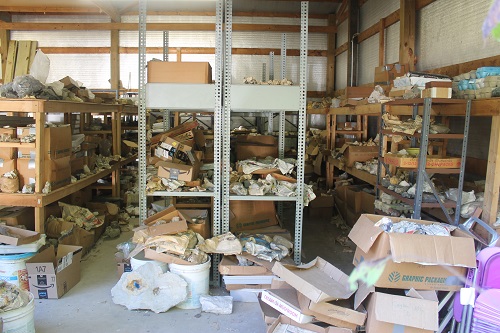
A garage full of rocks after 80% of the material has been removed.
I’ve got too many specimens. (Really!) What should I do?
I have a coffee mug that reads, “I have too many fossils, said no collector, ever.” Is that true? Maybe, maybe not. I’ve been collecting for over 60 years. That’s plenty of time to build a collection with thousands of fossils and minerals. (I’m closing in on 10,000 cataloged specimens.) How about you?
Options depend on the quality and quantity. If your collection is large, there are specimens you haven’t seen since you brought them home. Here are a few tips that your family might appreciate – and maybe you, too:
1) Slow down your collecting. Take hobbyists out. Yes, this is an option! During collecting trips, give specimens you find to others. I do that when I’m with budding rockhounds or visiting club members.
2) Donate your duplicates. Save a few that you like the best and rehome the rest. Over the years, I’ve done this with thousands of specimens.
3) Donate your most unusual/rare fossils or minerals. Nine new species to science were collected from a fossil crinoid site I discovered. Other species had better preservation than the type specimens. Most are in the Smithsonian and the Orton Geological Museum. I’ve also found specimens that now reside in the Indiana and Mississippi State Museums.
Donating to a museum isn’t as easy as it sounds. Museum curators and collection committees must be selective with what ends up in their permanent collections due to the long-term storage cost (Goldstein, 1989). A fossil or mineral must be unique and have good locality data. Museums rarely accept specimens with the condition, ‘it must be displayed.’ Donations to education collections are more likely to include those that can be used in programs where everything is replaceable.
4) Donating to university geoscience departments is worthwhile because students can use specimens in classes and labs to further their knowledge. I donated nearly a thousand samples from mine dumps around the country to the University of Arizona School of Mining and Mineral Resources after a request from an alumnus. Who knew? A university can become low on specimens for student studies. I didn’t need them!
5) Offering a collection to K-12 schools sounds good, but science education rarely includes in-depth earth science, and/or real samples aren’t required in the lessons. Talk to science department heads at your nearby school or the school district’s curriculum office. I’ve given collections to teachers who want to return them when they retire.
6) Give things away for club meetings and shows. Specimens can be donated for club sales or given to attendees to promote joining. You might sell specimens there if the club allows, especially if it’s specimens not found on club field trips.
7) The collector should rehome (I prefer that word to ‘dispose of’) specimens. Your family may opt for the easiest method. Selling your fossils and minerals at club shows or on eBay is a LOT of work. It’s not something your family won’t consider when you pass. Dealers may be interested in your stock at a cost that’s pennies on the retail dollar. That’s an easy way for them to build up retail inventory, and the fewer, better specimens make it worthwhile when the bulk of the collection is low-quality, low-value.
To determine if what you have is something that others will buy, attend shows to see what’s selling. Talk to dealers carrying similar material. Look at the quality and price to determine if you have something that will sell. If you want to sell at a show, research the cost.
The Legacy Question: Where will your collection go to die?
Think about your legacy. You have one, whether you realize it. The ‘do nothing’ approach, option 1, is the forgotten legacy. A life of collecting disappears when your family pays someone to haul it in a dumpster to a landfill. Or maybe it’s dumped in a gully on a farm. That might happen when a family doesn’t know what to do with it!
In the long-term legacy, option 2, part or all of the collection is donated to a museum or a school where it may be enjoyed or used to help future Earth scientists, educators, and hobbyists. This approach involves planning and developing contacts. Some museums have a budget to purchase unique specimens, but rarely whole collections.
The profitable legacy, option 3, is selling or auctioning the collection. It’s more convenient to sell a collection to one dealer. Auctions allow collectors to buy wholesale. Only high-end specimens sell for thousands of dollars.
What can you do? What did I do?
It took Ed Clement seventeen years for his father’s collection to become the Ben E. Clement Mineral Museum in 1997. With Ed’s passing in 2023, one of Ben’s granddaughters is carrying her father’s mantle. This type of legacy is rarer than platinum!
Illness or death is not preventable, but the loss of legacy is. I think Gerard Troost’s near-13,000 specimen mineral collection (see Goldstein, 1983). Started in 1810, the Troost collection, having survived several unsuccessful attempts to sell it to the State of Tennessee, its burial to keep it safe during the Civil War, and eventual sale and transfer to the Louisville Free Public Library Museum in 1880. Much of the collection was inundated by the muddy Ohio River, located a mile away, in the 1937 flood. The library museum closed in the mid-1970s, and the collection was transferred to the Museum of History and Science in 1976. That became a science center in 1988. Today, they are rehoming their collections to other museums and educational institutions, better at preserving them for the long term. The Troost collection now resides at the Indiana State Museum. It took several years to transfer because of the volume, the pandemic, and the fact that some specimens were mixed with other collections. That’s one collection that has been through hard times and shows it, but its legacy is intact.
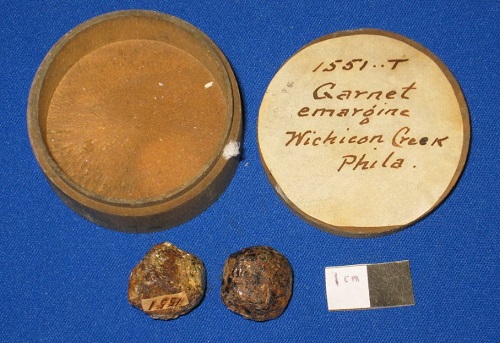
Garnet crystals from Gerard Troost’s mineral collection, collected in the 1810s. The label is in his handwriting.
Helping several friends sell their collections makes me aware of mine. As a result, I have created a plan to help my daughters.
- Does your family know your intentions?
- Do you know your intentions?
- Is your collection noted in your will?
Put the handling of your collection in your will in case something happens before you have a chance to do it yourself.
My collection reflects my life and interests. There are well-documented fossils and minerals. What happens to them is important to me. The will states which museums can select specimens. I investigated where my specimens would be beneficial for science. (Display is up to the exhibit designers.) I have reached out to curators, making them aware. I intend to donate before I’m too infirm – hopefully a long time from now!
I don’t mind sharing my plans to give you ideas.
- The Indiana State Museum has the first choice of specimens from that state.
- Illinois-Kentucky fluorspar district specimens, books, photographs, and memorabilia will go to the Ben E. Clement Mineral Museum.
- Kentucky specimens can go to the Kentucky Geological Survey and the Cincinnati Museum Center’s natural history museum.
- I have a few odds and ends for the Smithsonian (several crinoids to add to the previous donation and a section of the first core drilled in Antarctica, it’s a long story!).
- Minerals not taken by the above museums can be sold to a dealer so my daughters can benefit.
It is much better, but not easier, to handle the transfer of your collection while you are among the living. You don’t have to give it all away – start with a few specimens.
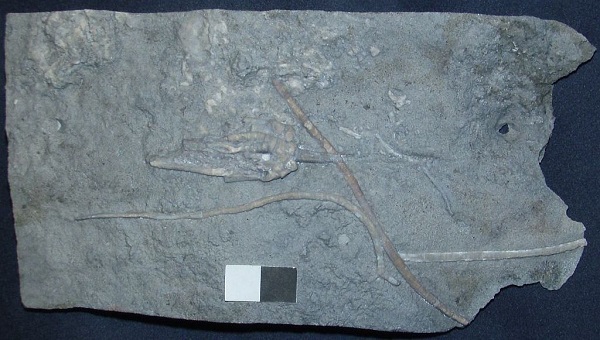
Working in the museum field for forty years has given me experience with legacy collections. Handling them can be a wonderful or horrible experience. Ultimately, only you can prevent your life’s love and interest, your legacy, from being forgotten, perhaps buried in a landfill, unseen by future rockhounds.
If you have any questions, feel free to contact me – alangoldsteinwriter @ gmail.com.
Bibliography
Goldstein, Alan, 1984. The Mineralogical Record, Gerard Troost and His Collection, Sept. – Oct.
1989. Mineral News, What makes a mineral collection valuable to a museum? January.
Jardine, Boris, Kowal, Emma, and Bangham, Jenny, 2019, The British Journal of Natural History,
accessed 4-30-205: How collections end: objects, meaning and loss in laboratories and museums | BJHS Themes | Cambridge Core
